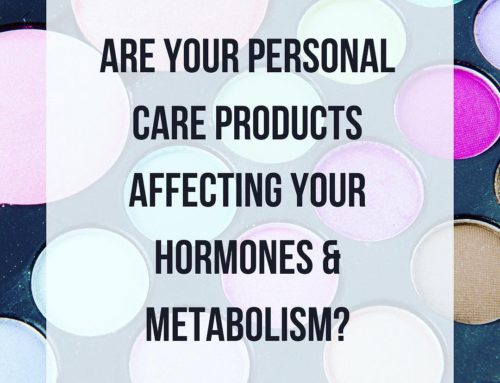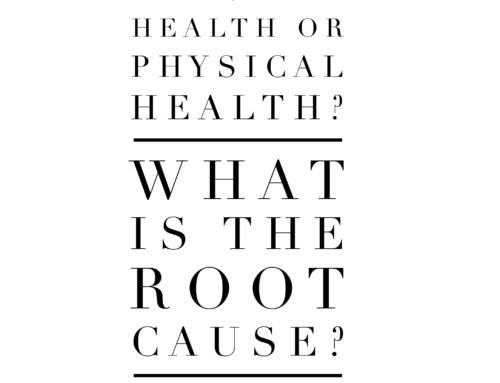Part 1 of the Breaking Barriers in Your Health and Weight Loss Goals series was all about Mindset – mindset is foundational to any change so if you’ve started with this article, please go back and read that one first!
As I discussed in Part 1, besides nutrition (and sugar handling), there are 4 other foundations I work from when addressing body composition. We talked about mindset already. The other big players are: gut health, adrenal health, and timing (keep an eye out for the next articles!).
Gut Health and the Brain
Although in Part 1, I talked about how mindset is foundational to any change, sometimes, gut healing is required to help with mindset – the reason why is if you have digestive dysfunction then you likely have some brain dysfunction. Intestinal permeability (or “leaky gut”) as well as disrupted gut flora (now called microbiota – referring to the micro-organisms of the digestive tract) can greatly affect brain health.
Intestinal permeability is the state in which undigested food particles break through the intestinal wall, enter the body, causing an immune response. Once scoffed at in conventional medicine, just plug the keyword “intestinal permeability” into the PubMed search engine and you can spend years reading the mountain of research on the subject.
Mounting scientific studies are also revealing how changes in the composition of the gut microbiota influence human physiology and contribute to diseases ranging from inflammation to obesity. Did you know that your gut microbiota contains tens of trillions of bacteria – ten times more cells than in your body? My last search on Pubmed presented 17,564 articles on the subject.
Do you have brain fog, memory loss, attention issues, mood swings, an autoimmune condition or simply diminished vitality but no digestive issues? It turns out that you can have a leaky gut and/or disrupted microbiota without even having digestive issues. Although digestive issues of leaky gut are often gas, bloating, inconsistent eliminations, abdominal and even joint and muscle pain – sometimes people have lived their whole lives that way without realizing it’s not normal.
The article, ” The microbiota–gut–brain axis: neurobehavioral correlates, health and sociality” by Augusto J. Montiel-Castro, Rina M. González-Cervantes, Gabriela Bravo-Ruiseco, and Gustavo Pacheco-López published in the Frontiers of Integrative Neuroscience, 07 October 2013 states:
“Recent data suggest that the human body is not such a neatly self-sufficient island after all. It is more like a super-complex ecosystem containing trillions of bacteria and other microorganisms that inhabit all our surfaces; skin, mouth, sexual organs, and specially intestines. It has recently become evident that such microbiota, specifically within the gut, can greatly influence many physiological parameters, including cognitive functions, such as learning, memory and decision making processes. Human microbiota is a diverse and dynamic ecosystem, which has evolved in a mutualistic relationship with its host. Ontogenetically, it is vertically inoculated from the mother during birth, established during the first year of life and during lifespan, horizontally transferred among relatives, mates or close community members. This micro-ecosystem serves the host by protecting it against pathogens, metabolizing complex lipids and polysaccharides that otherwise would be inaccessible nutrients, neutralizing drugs and carcinogens, modulating intestinal motility, and making visceral perception possible. It is now evident that the bidirectional signaling between the gastrointestinal tract and the brain, mainly through the vagus nerve, the so called “microbiota–gut–vagus–brain axis,” is vital for maintaining homeostasis and it may be also involved in the etiology of several metabolic and mental dysfunctions/disorders.”
The brain communicates with the gut microbiota via the vagus nerve for digestive functions such as:
- the secretion of digestive juices (stomach acid/digestive enzymes);
- the contraction of the gallbladder (to release bile to break down fat and to remove toxins from the body);
- to signal the Migrating Motor Complex Intestinal motility (action of nerves/muscles which moves the food the contents through your intestines through to elimination).
Circumstances or conditions that can cause poor gut health run the gamut, examples include the result of a brain injury, chronic stress, food allergies/intolerances, medications, over consumption of refined foods, infections, gut health at birth and much more. For more about the latest science behind how gut health affects brain health and vice versa, I recommend checking out the book: Why Isn’t My Brain Working?: A Revolutionary Understanding of Brain Decline and Effective Strategies to Recover Your Brain’s Health by Dr. Datis Kharrazian. Depending on the individual, as a practitioner, I often use the strategies I learned from this book and from brain chemistry training developed by Dr. Kharrazian.
Gut Health and Body Composition
By now you can probably grasp why imbalanced gut microbiota and a leaky gut can lead to health issues or prevent healing if not address, but what does this have to do with body composition?
A number of factors, actually, here are a few:
- Toxins are stored in your fat cells, so if you do not have healthy, open elimination pathways (colon-bowel movements, kidneys-urination, skin-perspiration, and/or lungs-breath), your body’s innate intelligence may hold on to that fat as a protective measure so that poisonous toxins are not recirculating in your body.
- Yeast overgrowth not only causes you health problems such as fatigue, skin irritations, itchiness, fatigue, sugar cravings, immune stress, and a whole lot more, it can cause significant water retention and bloating.
- Overeating due to malnourishment can happen with the consumption of refined foods, as the body craves more because it’s craving nutrients and, it can also occur when someone has poor nutrient absorption due to digestive dysfunction.
- Weak thyroid and Adrenal health can affect body composition due to reduced metabolism and reduced adrenal glandular activity impairs the body’s ability to convert stored fat into glucose. [This subject will be addressed in a follow up article.]
For more about how gut health affects obesity, enter the keywords words “microbiome and obesity” into the Pubmed search engine (also try “microbiota” and “obesity”).
Addressing Gut Health
Food sensitivities
Food sensitivities will stress to your body causing all sorts of problems from digestive upset or even many symptoms that have nothing to do with the digestive tract such as eczema, asthma, rashes, headaches, and even serious autoimmune flares. Until your gut is healed and microbiota balanced, stressors should be removed. Let’s look at some various approaches.
Baby Steps
If you are new to taking charge of your nutrition, you can start with baby steps. Foods are not the only stressors to the gut, start with sleep (see my article, Got Sleep, 11 Ways to Make it Better), stress relief exercises (etc. meditation, walking, yoga), then chose a food or beverage item a week to eliminate. Removing things like sodas and energy drinks, or perhaps a sugar ladened coffee drink is a good place to start – replace these with pure water.
Next remove gluten (but don’t replace it with gluten free processed foods), then dairy, then sugar, then legumes. Replace your transfats, vegetable oils, fake butters and canola oil with coconut oil, olive oil, fat from pastured/grass-fed animals. Using a book like Practical Paleo by Diane Sanfilippo is a good start to some great, easy to read information. Another book I recommend is Real Life Paleo: Swap, Remove, Heal by Stacy Toth & Matthew McCarry.
Autoimmune Protocol
If you are currently implementing a whole food/Paleo diet but still need help to heal, there are a couple ways you can move forward to healing. One way would be to start with an autoimmune/anti-inflammatory protocol. That means in addition to avoiding grains, dairy, legumes, and sugar – you also should do a trial elimination of nuts, seeds, eggs, and nightshade vegetables (tomatoes, potatoes, eggplant, & peppers are the main ones).
I recommend reviewing the autoimmune meal plan in the book Practical Paleo by Diane Sanfilippo. In addition, two other resources I love are The Autoimmune Paleo Cookbook by my friend and fellow NTP, Mickey Trescott and the well researched book, The Paleo Approach by Sarah Ballantyne, phD.
GAPS/SCD/SIBO
For digestive challenges or alternative to an autoimmune protocol, I highly encourage a specific gut healing approach. As a certified GAPS practitioner trained by Dr. Natasha Campbell-McBride, I recommend the protocol she developed and outlined in her book, Gut and Psychology Syndrome. Natural treatment for autism, ADHD⁄ADD, dyslexia, dyspraxia, depression and schizophrenia. In support of those on any gut healing protocol, I especially LOVE the new book: The Heal Your Gut Cookbook Nutrient-Dense Recipes for Intestinal Health Using the GAPS Diet by Hilary Boynton and Mary G. Brackett. If you’d like to know a bit more about the GAPS Nutritional Protocol, go to www.GAPS.ME.
The Specific Carbohydrate Diet (SCD) is the foundation of where Dr. Natasha Campbell-McBride started her healing journey with her then autistic son and refined to the GAPS diet. I know of many success stories using the SCD diet. For more about the SCD protocol, visit: www.breakingtheviciouscycle.info.
A SIBO (small intestinal bacterial overgrowth) protocol is often a SCD/low-FODMAP combination as a foundational approach. To learn more about this protocol, check out the work of Dr. Allison Siebecker at SIBOinfo.com. Also, when you subscribe to DianeSanfilippo.com, you receive a free download of the guide, SIMPLIFIYING SIBO which I am co-author of. The guide is essentially a recap of the SIBO Symposium, hosted by Dr. Seibecker held earlier this year at the SIBO Center in Portland, Oregon. The guide includes the transcript of an excellent interview of Dr. Siebecker with Diane Sanfilippo from the Balanced Bites Podcast #135.
Nutritional Balancing with Hair Tissue Mineral Analysis
This requires a more comprehensive discussion than we have room for in this article but I find this one of my more powerful tools, especially when all else has been tried. Mineral imbalances and toxic heavy metals can cause problems to your entire physiology. Often when people heal but then become unwell again, mineral imbalances and heavy metal toxicity are barriers that need to be overcome so that deep healing to happen. Proper testing and expert interpretation is key to understanding how to best utilize the data a hair analysis can provide. A properly trained practitioner is also very important. Stay tuned for a more comprehensive article or send me an inquiry if you’d like to know more!
Simple, Effective Gut Healing Tools
First I’d like to point you to an excellent series that discusses the digestive process: Troubleshooting Your Digestive Issues by Diane Sanfilippo. Even if you don’t think you have digestive problems, if you face any health problem then read that series – it contains some very practical tips for improvement.
Next I’ll just share one of my very favorite tools I use that supports gut healing by stimulating the vagal nerve. [As a practitioner, I use various tools for stimulating the gut-brain axis via vagal nerve stimulation and will likely write more about that in a later article.]
PARMASYMPATHETIC —Digestion begins in this state.
In the context of a nutrient dense whole food diet, one of my favorite tools to use is a product by Vibrant Blue Oils (professional practitioner line therapeutic grade oils) called Parasympathetic. The company, Vibrant Blue Oils, was founded by a fellow Nutritional Therapy Practitioner, Jodi Cohen, and the professional line was developed by one of our Nutritional Therapy Association (NTA) senior instructors (also a practitioner), John Tjenos.
The instructional guide that accompanies your bottle of parasympathetic reads:
“The Brain and the parasympathetic state of the automatic nervous system are the furthest north in the digestive system. The autonomic nervous system needs to be in a parasympathetic state to signal the vagal nerves – two cranial nerves that extend from the brain stem to the abdomen. This triggers all the parasympathetic responses in the digestive cascade, including stomach production of HCL, the release of pancreatic enzymes, the gall bladder’s release of bile for fat digestion in the duodenum, the work of brush border enzymes in the small intestine and all the sphincters including the lower esophageal sphincter… Vibrant Blue Oils Parasympathetic blend is uniquely suited to stimulate the parasympathetic state. We know that the brain needs nutrients, circulation and stimulation. The latter element, stimulation, is the hardest to provide through nutritional therapy. This is where essential oils, with their unique abilities to reach the inner brain through nasal pathways and stimulate the nerve endings in the skin which connect to the parasympathetic nervous system, fill a critical void.”
Additional Gut Healing Favorites
Intestinal Mucosa by Vibrant Blue Oils— I personally keep this one along with parasympathetic, and the oil below in my purse. “The integrity of the epithelial lining of the small intestine determines nutrient absorption and malfunction leads to food intolerances. Intestinal Mucosa oil is especially useful in Leaky Gut conditions.” -VBO
Lastly, I use Vibrant Blue Oils Anti-inflammatory. The benefits are for more than just gut healing but for the purposes of this article, it helps with small intestine inflammation as well as brain inflammation.
Wrapping it Up
In summary, I could write an entire book on this subject and likely even a series of books. Clinically, I look at each client as an individual. There is no one size fits all. There are a variety of factors that contribute to health. It’s a multifaceted approach as well as individualized. There are some common factors that can help everyone though, and those are:
• Positive Mindset
• Blood Sugar Handling
• Stress Management
• Adequate/restorative Sleep
• Appropriate Movement/Exercise
• Nutrient Dense Whole Food as close to nature as possible
• Adequate Hydration
• Healthy Digestive function/microbiota
• Reduction of environmental/heavy metal toxins
• Methods/Exercises to increase plasticity/function of the vagus pathway
• Mineral BalanceAs a nutritional therapy practitioner, I believe in bio-individuality. I work with a variety of conditions, using a variety of tools and methods, including integrative blood chemistry analysis and other modalities as mentioned above, helping my clients bring balance to their body with real food, targeted nutrients, and lifestyle modifications so they can heal and attain optimal, vibrant health. There are many paths to healing and there is a path that is right for you.
In good health,
Holly Morello, NTP
Owner and Nutritional Therapy Practitioner at www.NourishingExcellence.com
Lead Content Developer and 1:1 Coach at www.DianeSanfilippo.com






